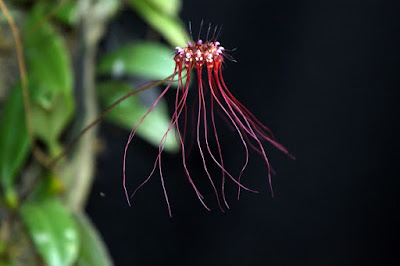Bulbophyllum gracillimum is native to Thailand, Singapore, Malaysia, Sumatra, Indonesia and further east to New Guinea, northeast Australia, Solomon Islands, New Caledonia and Fiji. This orchid grows in lowlands at a height below 500 m. It is most often found on the lower branches of trees in rain forests.
Bulbophyllum gracillimum, also called as The Graceful Bulbophyllum, The Wispy Umbrella Orchid, Bulbophyllum leratii, Bulbophyllum psittacoides, Bulbophyllum ruficaudatum, Cirrhopetalum gracillimum, Cirrhopetalum leratii, Cirrhopetalum psittacoides, Cirrhopetalum warianum, is a species of the genus Bulbophyllum. This species was described by Rolfe in 1912.
IDENTIFY BULBOPHYLLUM GRACILLIMUM
Bulbophyllum gracillimum is native to Thailand, Myanmar, Malaysia, Sumatra, Java, Borneo, Moluccas, New Guinea, Sulawesi, Solomon islands, Australia, Fiji and New Caledonia. This orchid grows in the lowlands in these areas, usually under 500m. It is most often found on low branches of trees in rainforests. In Malaya, where it is quite widespread, it can be found in the vicinity of Pinang, Perak, Negri Sembiilan and Pahang.
It is a miniature sized, hot growing epiphyte, which can reach the height of 12 cm, with small, ovoid, wrinkled, green to dark green pseudobulbs (a length of 1.5-2.0 cm and a width of 0.5-0.9 cm) clustered close together and a single, apical, elliptic leaf. The leaves are usually 6-8 cm long, 1.5-2.5 cm wide, but sometimes they grow up to 12 cm, shiny, dark green on the upper surface and dull green on the bottom.
The Graceful Bulbophyllum blooms in the spring through summer on an erect, 6 to 12" (15 to 30 cm) long purple, wiry inflorescence that has a head of 6 to 10 fragrant flowers at the apex held well above the leaf. The flowers are variable in color, most often are dark purple-red with a purple-violet lip, but the colors can vary from white to creamy to pink with purple to white peaks of some parts. A distinctive feature of flowers of this species are long, narrow, hanging lateral sepals of 2.5-3 cm in length, sometimes even 5 cm. The upper sepals are ovate with a long, drooping filiform tip. The edges of the hooked upper sepals and hanging petals are covered with hairs. The lip is mobile and fleshy.
BULBOPHYLLUM GRACILLIMUM CARE AND CULTURE
Cultural information should only be used as a guide, and should be to be adapted to suit you. Your physical location; where you grow your plants, how much time you have to devote to their care, and many other factors, will need to be taken into account. Only then can you decide on the cultural methods that best suit you and your plants.
Light:
Bulbophyllum gracillimum needs a light level of 12000-18000 lux. It requires quite shady positions, and the light must always be filtered or dispersed. Strong air movement should be ensured all the time.
Temperature:
It is a thermophilic plant. The average day temperature during the whole year is 29-32 ° C, night 21-22 ° C, which gives a daily amplitude of 8-10 ° C.
Humidity:
The Graceful Bulbophyllum needs a humidity level of about 85% throughout the year.
Substrate, growing media and repotting:
Bulbophyllum gracillimum can be grown attached to pieces of tree ferns or cork with high humidity and daily watering during the summer. In the period of extremely hot and dry weather, it may require even several waterings during the day. These plants can also grown in baskets or shallow containers filled with loose, fast-drying ground that undergoes very slow decomposition.
These plants react adversely to the violation of the root ball, so they should not be split or repotted when the base maintains a loose structure and provides good drainage. When repotting is necessary, it is best to choose the moment when new roots appear, then the plant will recover faster.
Watering:
The substrate of cultivated plants should be constantly moist and should never completely dry out. The substrate should never be soaked, and there should be excellent air circulation around the roots.
Fertilizer:
Bulbophyllum gracillimum should be fertilized every week 1/4-1/2 of the recommended dose of fertilizer for orchids. A fertilizer with a high nitrogen content is beneficial from spring to mid-summer, and a fertilizer richer in phosphorus should be used in late summer and autumn.
Rest period:
There is a slightly drier period in summer and a second late winter, cultivated plants need less water if light is scarce, temperatures are low or days are short. However, these plants should never be dried.















COMMENTS